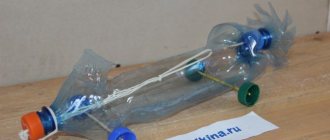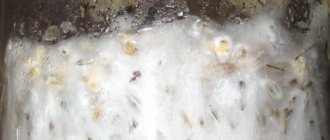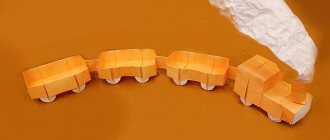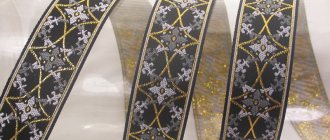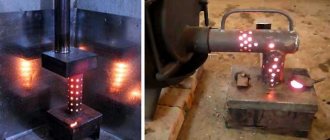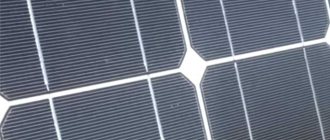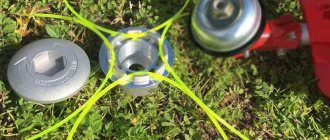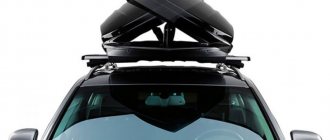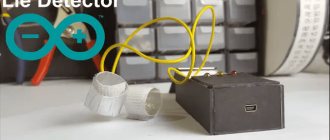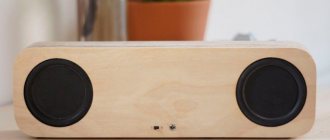I won't tell you how to make a children's electric car from scratch. Since this is quite labor-intensive, and it’s unlikely that the result will turn out as beautiful as we would like.
Therefore, I’ll tell you how to make a children’s electric car with your own hands from an ordinary children’s car. The main thing is that there are wheels, a steering wheel and an attractive body. And if all the parts and materials are available, the electric car can be manufactured in 1 day.
It all started when my son’s godfather gave him a car (a pushchair) for his first year of birth.
The principle of driving such a machine was that the child sitting on it had to push off the floor with his feet.
But the problem was that my one-year-old son could climb onto the car, but he had difficulty pushing off the floor with his feet; he was still too small.
In this regard, it was decided to modernize the vehicle and install an electric drive. Under the “hood” of the car, as it turned out, there is a lot of free space to accommodate the battery and electric drive.
- Having seriously thought about this question, I was interested in what engine to use for a children's electric car.
- Going into my garage, I caught my eye on a gear motor from a car windshield wiper (two-speed). After searching the Internet, I found its characteristics:
- Supply voltage - 12V Power on the gearbox shaft - 10W Rotation speed on the gearbox shaft at lower speeds is 30–40 rpm Rotation speed on the gearbox shaft at high speeds is 55-70 rpm
- Current consumption - up to 4A
I connected the gearmotor to the battery and tried to stop the rotation of the shaft by hand, but that didn’t work. The shaft was spinning without a hint of the load that had arisen. This suited me quite well, and I began to consider options for placing the gear motor under the car.
The most successful location for placing the gear motor was in the rear axle of the car, while the rear wheel shaft successfully passed through one mounting hole of the gear housing (circled in the photo in red). At the same time, the battery could be easily placed under the seat. Everything was fine, but for this placement it was necessary to make two gears.
But I had no desire to stretch out the pleasure for several weeks. Therefore, I decided to use another, simpler and faster method - to place the gearmotor under the seat (where the battery was supposed to be) and connect it to the rear axle with a belt drive.
I went to the market in search of the smallest belt. The smallest belt that was offered to me was the z-500 . Based on the size of the belt and the free space under the car, I started making pulleys.
To make the pulleys, I used PVC plastic 5 mm thick. First, I drew a circle with a compass (two large diameters and one smaller one), and then started cutting.
This PVC plastic, not very dense, can be cut very easily with a utility knife, but you can also use a jigsaw. Don’t despair if your circles are not quite even; in the future we will sand them down.
To do this, drill a hole in the center, insert a bolt and tighten it with a nut. We insert it into the drill and at high speeds we begin to process the edges with sandpaper or a file. Thus, we obtain an ideal circle. Don’t forget to grind the bevels at an angle on large circles.
We drill out the central hole to match the diameter of the wheel hub, and thread the pulley onto the wheel. In order for the pulley to sit dead in the wheel, it is enough to screw the pulley completely to the wheel with two screws.
The pulley for the gearmotor had to be made of a smaller diameter so that it would not cover the mounting holes of the gearbox. And due to the fact that the pulleys had to be made of different diameters, the electric car lost a little speed (instead of 1.5 km/h it got 1 km/h).
After all that was done, I started assembling the electric car. Having installed the belt between the wheel and the gearmotor, I saw that there was a gap of 2 cm from the base of the engine to the steering column and it was quite possible to make the pulley on the wheel 1 cm smaller in diameter. But I didn’t want to redo anything anymore.
For reliable fixation, the engine casing was secured with a clamp and tightened with bolts. And through the gearbox casing I installed a rod from the d-4mm electrode. (in the future I will change it to an M6 threaded rod, this way the gearmotor will be securely fixed).
To connect the electrical part, I used automotive terminals and crimping pliers (you can use a soldering iron and pliers). I put thermal tubes on the terminals as insulation. I used wires with a cross section of 0.75.
- Electrical diagram of a two-speed windshield wiper motor
- A - the numbering order of the terminals in the wiper block; 1 — windshield wiper motor; 2 — reusable thermobimetallic fuse to protect the gearmotor from overloads; a — second speed brush; b — first speed brush; c — spring plate of the limit switch; d, e - limit switch contacts;
- To control the movement of a children's electric car, I decided to place a control button on the steering wheel so that the child consciously understands that when this button is pressed, the electric car begins to move (for older children, you can make a pedal).
- Therefore, we had to modify the steering column, namely, drill holes in the ribs for pulling wires.
The button was used by KM1-1 (Soviet times), its advantage is that it is miniature but can switch currents up to 4 A. It’s not very elegant, but what can you do, I didn’t have another button.
- To mount it, I drilled a hole in the steering wheel.
- On the back of the steering wheel, I glued the wires with a heat gun and filled the button itself with silicone.
All that remains is to install the battery. For these purposes, it is necessary to use gel batteries (from flashlights, uninterruptible power supplies, etc.). Don’t forget to additionally bring out the wires to connect the charger.
I had a 12V 7.2A UPS battery (theoretically, its capacity should be enough for 1-1.5 hours). It was too big to fit under the electric car, so we had to take it outside.
But as it turned out, it fits right next to the backrest. And without hesitation, I tied it with electrical tape. The battery was installed upside down so that the child had less chance of tearing out the wires.
- Under the “hood” of a children's electric car, do not forget to tie all the wires with plastic clamps so that nothing breaks while driving.
A DIY children's electric car is ready for use. Having put my one-year-old son on an electric car, I noticed that it was very difficult for him to press the button (it was very hard), in the end I had to help him and press the button himself.
Technical characteristics of a homemade electric car for children: - weight of the electric car - 5.7 kg. — speed — 1 km/h (quite sufficient for children under 2-3 years old to drive around the house)
— load capacity 20 kg. (at 30 kg the belt began to slip).
I think it’s not a bad speed at all for a baby. And when my son grows up, then I’ll make a bigger and faster electric car for him
